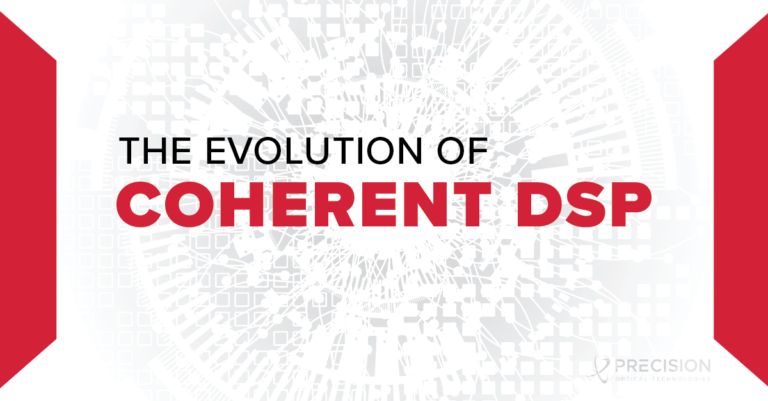
The Evolution of Coherent DSP

Introduction
One of the best ways to push past limitations is to find new paths where limits no longer apply. Such is the case with coherent optical transport. This cutting-edge technology transcends traditional fiber-optic networking speed limits by modulating light signal intensity (amplitude), phase and polarization. In today’s blog, we’ll discuss the development of coherent technologies and their impact on high-speed networks.
Coherent & DSP Technologies
Coherent strategies have evolved over time as a response to the challenges of ever-increasing network capacity demands. With older optical receivers only capable of processing on/off light signals, bit rate had a one-to-one correspondence with baud rate. Network operators faced challenges as they attempted to move past speeds of 10G, and experts looked towards digital signal processing (DSP) algorithms that could interpret several aspects of a signal. This would ultimately allow multiple bits of data per baud to be sent.
DSP technologies also solved a key challenge of high-speed transport; it compensated the signal dispersion found as speed and distances increase. Upgrading fiber and adding more regenerators was an early-term solution that ultimately proved unrealistic from a cost standpoint. DSP eliminated this issue and made it possible to increase capacity without the requirement of new fiber installations.
ACO vs. DCO
Digital signal processors can live in two places within the network – within the optical module itself (digital coherent optical, “DCO)”, or off-module (analog coherent optical, “ACO”). The two device types have developed an oft-traveled, cost-driven path that balances a network’s “line side” (optical backbone) with its “client side” (the interface where traffic connects).
The process tends to play out as follows. Early iterations of optical line cards are proprietary to specific manufacturers, offering no compatibility to those produced by other manufacturers. Sufficient adoption of the technology tends to push development to the client side, where there is a much greater need to connect various types of devices. This allows multi-source agreement (MSA) standardization to emerge — first as transponders hard-attached to line cards, and later as pluggable form factors. Eventually, the technology matures sufficiently to send standardization back to the line side.
Coherent Technologies
In the coherent context, the jump from 10G to 40G architectures proved instructive to this process. A 4×10 approach ultimately took root as a low cost alternative to 40G coherent solutions. The success of enabling higher speeds through smaller increments led to a 4 x 25G solution for coherent 100G. The technology is now sufficiently mature to support interoperability of 100G optical cards on the line side, and the development of 400G coherent transport is in its implementation stage.
Both ACO and DCO device types continue to contribute to the development of Coherent DSP. ACOs are a natural fit for proprietary line-card DSP interfacing since they create less heat than DCOs and are capable of longer transmission distances. DCOs have their own advantages, particularly for short-range interconnect environments such as data centers. DCO’s can be reconfigured in real-time to address changes in demand, and they generally require less networking expertise.
As speeds of 400G and beyond come into sharper focus, coherent DSP undoubtedly will continue to evolve — and the lessons thus far learned will continue to inform development.
Contact Us
Precision OT provides cutting edge optical solutions to support coherent applications. To learn more about our product line, click here or contact info@precisionot.com.






